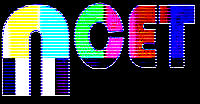 |
The Templeton Mixer consisted of three modules: the colorizer, the keyer, and the mixer. Though the appearance of the units looks simple, their versatility is nothing short of remarkable. The prototype modules were designed and built for NCET by Larry Templeton in 1970. The location of the original module set seems to be unknown
The mixer is the easiest to understand. Its function is to take in several signal sources and cross-fade, superimpose, recycle them back into itself, and/or send them to the other 2 modules. (as in the image below) |
 |
| |
|
|
| |
The keyer module samples the brightness range of a source image and can separate that source into eight distinct zones according to relative brightness (though all eight were rarely used). Color, or other image sources, can then be inserted into each of these zones. In the diagram below we use a simplified image to illustrate both the keying and colorizing functions. |
|
| |
|
|
| |
|
|
| |
The colorizer module supplies four different variable color sources. Each joy-stick control selects color from the spectrum by swinging the stick around a circle. The degree of deviation from center controls color saturation, and the top knob can be rotated to control color brightness. (diagram below) |
|
| |
|
|
| |
|
|
| |
When working with a real image such as this one... |
|
| |
 |
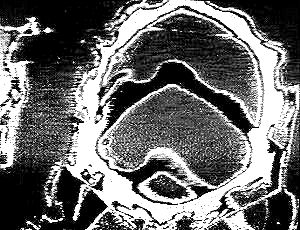 |
>>>> |
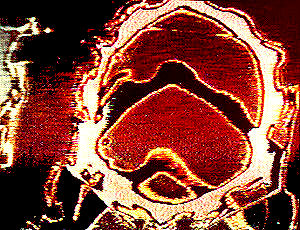 |
 |
| ~ Keyed ~ |
~ Colorized ~ |
|
|
| |
...the processing, and the result, are a clearly good deal more complex than our example. Add time, motion, color change, etc., and you might have something which could be considered video art. |
|
| |
|
|
| |
All functions of each of these mixer modules can be preset, varied manually in real time, or changed by control voltages derived from a separate source - the Buchla Box audio synthesizer, for instance.
~~~~~
To read Larry's original description of the modules, which he wrote for Vista Systems, his own company, through which he intended to market them, consult: Vista Systems.PDF (Adobe Acrobat file).
~~~~~
The photos below show a set of modules produced for Larry by Rick Davis. |
|
| |
 |
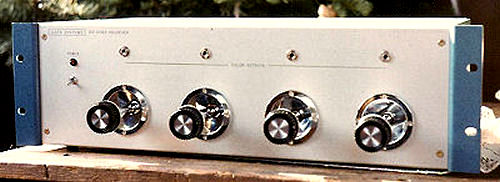 |
 |
| The colorizer from the front |
|
|
| |
|
|
| |
|
|
| |
~~~~~
|
|
| |
|
|
| |
|
|
| |
|
|
| |
~~~~~
|
|
| |
|
|
| |
NOTE: The 3 modules shown here comprise a later generation than the original prototype made for NCET. In particular, this one, the mixer, is quite a bit more sophisticated. Rick Davis, who built them, explains the mixer's functions and capabilities as follows:
"It was actually a 4 x 4 input and a 4 x 3 output configuration for a total of 16 inputs and 12 outputs. Each input channel can take 4 video signals in and mix them to one output bus....
"Additionally each output bus had 1 x 3 distribution amp, so that 3 isolated signals could be taken from each output. These signals in turn could be used to feed video to the colorizer, the multikeyer, or even back into another input channel in the mixer." |
|
| |
|
|
| |
 |
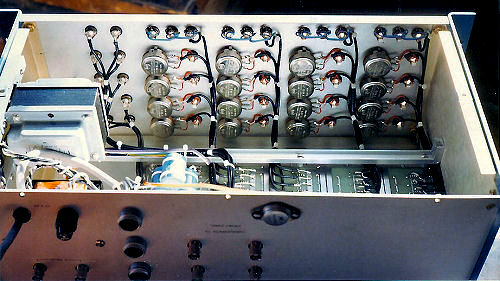 |
 |
| Inside the mixer from the back |
|
|
| |
|
|
| |
 |
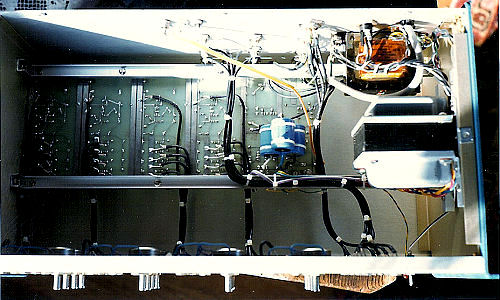 |
 |
| Inside the mixer from the front |
|
|
| |
|
|
| |
 |
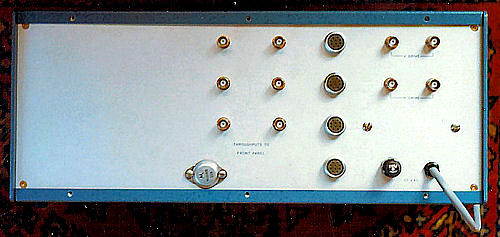 |
 |
| Mixer rear panel |
| |
Mixer photos by Rick Davis |
|
|
|
| |
|
|
| |
And here are some examples of NCET imagery processed through the Templeton Mixer |
|
| |
|
|
| |
|
|
| |
~~~~~
OK, so here's the kicker!
As of 2008 Rick Davis' copy of the mixer was located, taken to Larry Templeton's home, checked out, repaired and brought back into working order.
Quoting Larry's triumphant email:
"Bob Pacelli came up from Pacific Grove this morning and we spent several hours fine-tuning and working on the rejuvenated mixer/colorizer. Everything seems to be as it should be. Quite remarkable considering that it was built in 1972. Check out the attached images for a sampling.
"It's set up at my home in Los Altos. There are 2 cameras and a good (if small) color monitor. Anyone who wants to come work on it is more than welcome. Sometime in the next week or so, Pacelli will bring his Hearn colorizer up and we'll hook the two together.
"Stay tuned. Larry"
So, here is video artist Bob Pacelli, at Larry's house, plying the Templeton Mixer. |
|
| |
|
|
| |
|
|
| |
And here are some of Bob's feedback images using the resurrected modules. |
|
| |
|
|
| |
It still makes ravishingly beautiful imagery, doesn't it. |
|
